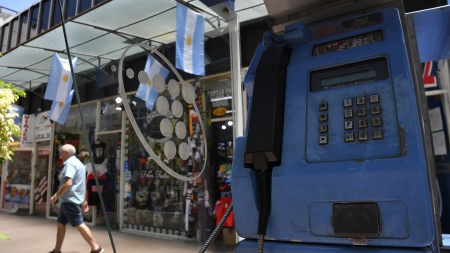
A total of 8,100 public telephones remain available in the country distributed in hospitals, shopping malls and train stationsused more for the tourist photo or the selfie than for its original function of communication, but now they have become a cult object for collectors who They come to offer them for up to 60,000 pesos on online sales sites and are even rented for 50,000 pesos per week.
The massification of mobile telephony in the mid-2000s was one of the main causes of its progressive disappearance from the public space. of these devices, reducing their presence to only 8,100 devices, according to a report carried out this year by the National Directorate for the Development of Competition in Networks and Services, an agency dependent on the National Communication Entity (Enacom).
In Buenos Aires city“there are less than 50 public telephones, if booths and kiosks that continue to provide the service are taken into account”, according to sources from the business borrowers Telecom and Movistar informed Télam.
“Today public telephones have a reinsertion value as material for collectors, who when they acquire them can use it as an ordinary telephone”
The famous cabins are hardly seen on public roads anymore and those that still work are in train terminals, hospitals or shopping malls, as indicated by the companies. In addition, since 2005 there is a program for the removal of these devices by the Buenos Aires Government and the borrowers when they cause damage to the neighbors or are vandalized.
A) Yes, many of them ended up in the hands of recyclers of technological artifacts, who are in charge of restoring, repairing or melting down these materials, as in the case of Juan Martin Ravettini, creator of Qué Reciclo.
“Today, public telephones have a reinsertion value as material for collectors, who when they acquire them can use it as an ordinary telephone,” Ravettini remarked.

Also many of the elements that made up the cabins, mainly metal and plastic, were “melted down to be reused”he added.
Nowadays, old public telephones can be purchased on internet sites at prices that vary according to their state of conservation: they range from $7,000 to $60,000.
As an example, the MercadoLibre user Zalatti Antiguedades offers for rent an “Immaculate Entel Cabin. Location for movies and advertisements” at 50,000 pesos per week, but does not sell it.
When communication stopped being a problem
The first public telephones were installed in the City of Buenos Aires in the 1930s.when the interconnection of all existing telephone networks in the country occurred and allowed most users to have the ability to communicate with each other, although still in a limited way because the number of devices available in homes was scarce.
According to José Luis Fernández, semiotician, teacher and researcher at the University of Buenos Aires“it was quite a milestone for the time if a family had a fixed telephone, because it was a completely scarce commodity and that also affected the price of the houses. A house with a telephone was much more expensive than one without the service”.
in 1937the Telephone Union Company installed dozens of telephone booths with insulating material in some points of CABA, such as Caballito, the microcentro, Retiro and Once to preserve the privacy of conversations.
The semiologist recalled that a public telephone user could “wait hours to be able to communicate due to the high demand of people to consume the service.”

In the mid 70’sthe National Telecommunications Company (Entel) carried out a massive installation of public telephones in the main cities of the country, which transformed this device into another element of urban architecture.
In the early 90’sEntel was privatized by the Government of Carlos Menem and in the AMBA area the concessionary companies doubled the telephone booths on public roads, which became a “space for interconnection between the urban and the inter-individual”, Fernández remarked.
“It was a sign that society needed to communicate more frequently and it was a precursor to the need for a cell phone”considered the semiologist.
In the early 2000sthe increase in the number of mobile phone users also caused a drop in the consumption of these devices for public use.
“With the rise of mobile telephony it was not necessary to be parked in a space. The appearance of mobile telephony generated a total revolution on the experience in urban space”
cell phone kills landline
The Enacom data reflects that from 2014 to the first quarter of this year the presence of these phones decreased by almost 35%, falling from 12,831 to 8,100. If the category of semi-public telephones and booths and cabins is added, the decrease exceeds 60% in the same period, from 78,458 to 30,967.
“With the rise of mobile telephony, it was not necessary to be parked in a space. The appearance of mobile telephony generated a total revolution in living in the urban space, because any walker can produce messages from anywhere”, remarked the semiologist.

One of the few public telephones that persist in the City of Buenos Aires is located on Paseo Imperial, located at Avenida Corrientes 2,513in the Monserrat neighborhood, where the artifact located in the center of the commercial space goes unnoticed among the dozens of people who visit the place every day.
“Many take a photo of it as a reminder of what it was, but I have never seen anyone who has used it,” said a local trader.
Another of those that is still standing is at the corner of Roberto Ortiz and Quintana, in the Recoleta neighborhood of Buenos Aires, but already transformed into the classic English red cabin that, in disuse, became one of the tourist attractions of the place.


















